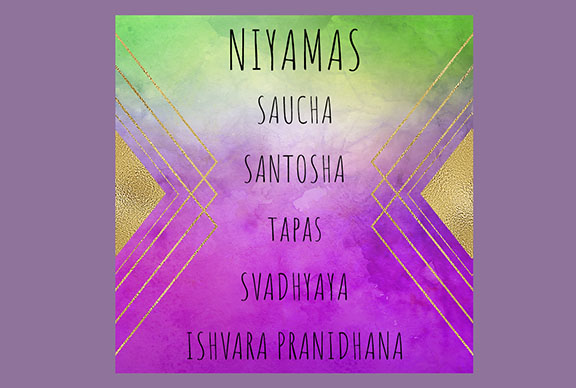 Rev. Jaganath, Integral Yoga Minister and Raja Yoga master teacher, has spent a lifetime delving into the deepest layers of meaning in Patanjali’s words within the Yoga Sutras. Our series continues with sutra 2.32. In sutra 2.30, we learned more about the first of the eight limbs of classical Yoga: yama, comprised of five universal resolves. In sutra 2.32 we learn more about the second limb: niyama.
Rev. Jaganath, Integral Yoga Minister and Raja Yoga master teacher, has spent a lifetime delving into the deepest layers of meaning in Patanjali’s words within the Yoga Sutras. Our series continues with sutra 2.32. In sutra 2.30, we learned more about the first of the eight limbs of classical Yoga: yama, comprised of five universal resolves. In sutra 2.32 we learn more about the second limb: niyama.
Sutra 2.32: śauca-santoṣa-tapaḥ-svādhyāya-īśvara-praṇidhānani niyamāh
Niyama – additional resolves yogis observe – consists of:
• Saucha – purity
• Santosha – contentment
• Tapas – accepting challenge, struggle, discomfort, and self-discipline as a help for purification
• Svadhyaya – regular repeated study and integration of sacred wisdom into one’s life
• Ishvara pranidhanam – wholehearted devotion and dedication to Ishvara (See 1.24)
śauca = purity
shining, glowing, gleaming, radiant, bright, white, clear, clean, pure, honest, virtuous, holy, a true friend, the condition of a religious student (See 2.5, 2.32, 2.40)
from śuci = clear, bright, luminous
Sauca is a strengthened form of suci. Purity for the yogi means overcoming the influence of ignorance, karma, subconscious impressions (samskaras), the klesas, and the gunas. It includes purity of body, mind, and intention. From this, we can deduce that an impurity – physical or mental – is anything that inhibits or obstructs the innate harmony among the various facets of the individual and the individual’s relationship to society and Nature.
In the Hindu tradition, purity comprises physical, mental, moral, and ritual purification. In Yoga, we don’t see ritual emphasized, although we can regard regular practice as taking the place of ritual.
santoṣa = contentment
pleasure, satisfaction, delight, joy, connectedness, to be joined or connected to (See 2.32, 2.42)
from sam = with, together, completely, absolutely + tuṣ = to be satisfied
Santosha is not about creating contentment by collecting as many pleasant objects and experiences as possible. The word carries a sense of being connected to something. To what? A clue to understanding santosha can be found in Hindu mythology in which santosha is personified as a son of the god Dharma and the goddess Tushti. Dharma, literally defined as that which holds together, is defined as duty, spiritual teachings, and living according to the way of wisdom. Tushti means contentment.
Santosha, then, is not just feeling good about the way things are going in your life. It is experienced when contentment is wedded to, or arises from, wisdom. It is not based on material attainments. Since wisdom is by nature stable, santosha is a stable happiness that exceeds pleasure based on the accumulation of possessions or accomplishments, or on the satisfaction of any sense desire. Those who experience santosha know the deep satisfaction that results from being fully integrated into the flow of life.
tapaḥ = accepting challenge, struggle, discomfort, and self-discipline as a help for purification; austerity, self-discipline, creative heat, consuming by heat, causing pain or trouble, distressing, tormented by, warmth, an attendant of Siva (See 2.1,2.15, 2.32, 2.43, 4.1). Refer to 2.1 for more on tapas.
from tap = to burn, to make hot
svādhyāya = regular, repeated study, study of sacred texts; self-study, reciting, repeating or rehearsing to one’s self, repetition or recitation of the Veda in a low voice to one’s self, recitation or study of any sacred text (See 2.1, 2.32, 2.44)
from svā = self + adhi = to go over or on + a = hither, unto + ya = from i = to go
Refer to 2.1 for more on svadhyaya.
īśvara = God; master, lord, king, able to do, capable (See 1.23, 1.24, 2.1, 2.32, 2.45)
Refer to 1.23 for more on Ishvara.
praṇidhānani = wholehearted devotion and dedication; to hold within and in front of, laying on, fixing, applying, dedication, access, entrance, exertion, endeavor, respectful conduct, attention paid to, profound religious meditation, abstract contemplation of, vehement desire, vow, threefold prayer (Dharmas) (See 1.23)
Ishvara + pranidhanam = wholehearted devotion and dedication to Ishvara.
niyamāh = additional resolves yogis adhere to; observances, internal disciplines (See 2.29, 2.32)
Refer to 2.29 for more on the niyamas.
About the Author:
 Reverend Jaganath Carrera is and Integral Yoga Minister and the founder/spiritual head of Yoga Life Society. He is a direct disciple of world renowned Yoga master and leader in the interfaith movement, Sri Swami Satchidananda—the founder and spiritual guide of Satchidananda Ashram–Yogaville and Integral Yoga International. Rev. Jaganath has taught at universities, prisons, Yoga centers, and interfaith programs both in the USA and abroad. He was a principal instructor of both Hatha and Raja Yoga for the Integral Yoga Teacher Training Certification Programs for over twenty years and co-wrote the training manual used for that course. He established the Integral Yoga Ministry and developed the highly regarded Integral Yoga Meditation and Raja Yoga Teacher Training Certification programs. He served for eight years as chief administrator of Satchidananda Ashram–Yogaville and founded the Integral Yoga Institute of New Brunswick, NJ. He is also a spiritual advisor and visiting lecturer on Hinduism for the One Spirit Seminary in New York City. Reverend Jaganath is the author of Inside the Yoga Sutras: A Sourcebook for the Study and Practice of Patanjali’s Yoga Sutras, published by Integral Yoga Publications. His latest book, Patanjali’s Words, is coming soon from Integral Yoga Publications.
Reverend Jaganath Carrera is and Integral Yoga Minister and the founder/spiritual head of Yoga Life Society. He is a direct disciple of world renowned Yoga master and leader in the interfaith movement, Sri Swami Satchidananda—the founder and spiritual guide of Satchidananda Ashram–Yogaville and Integral Yoga International. Rev. Jaganath has taught at universities, prisons, Yoga centers, and interfaith programs both in the USA and abroad. He was a principal instructor of both Hatha and Raja Yoga for the Integral Yoga Teacher Training Certification Programs for over twenty years and co-wrote the training manual used for that course. He established the Integral Yoga Ministry and developed the highly regarded Integral Yoga Meditation and Raja Yoga Teacher Training Certification programs. He served for eight years as chief administrator of Satchidananda Ashram–Yogaville and founded the Integral Yoga Institute of New Brunswick, NJ. He is also a spiritual advisor and visiting lecturer on Hinduism for the One Spirit Seminary in New York City. Reverend Jaganath is the author of Inside the Yoga Sutras: A Sourcebook for the Study and Practice of Patanjali’s Yoga Sutras, published by Integral Yoga Publications. His latest book, Patanjali’s Words, is coming soon from Integral Yoga Publications.
